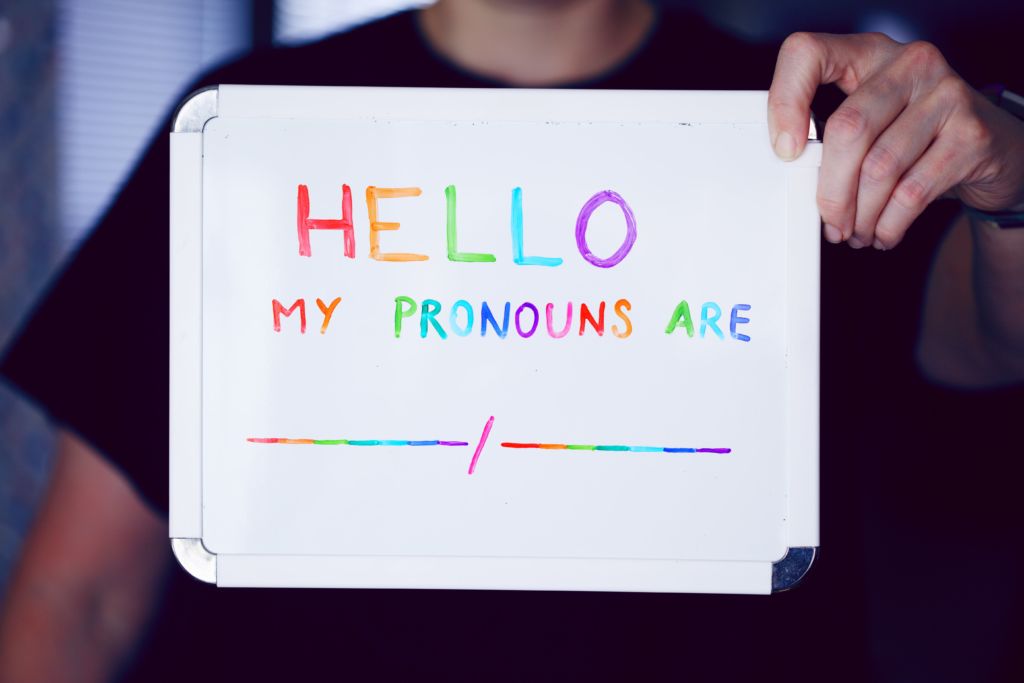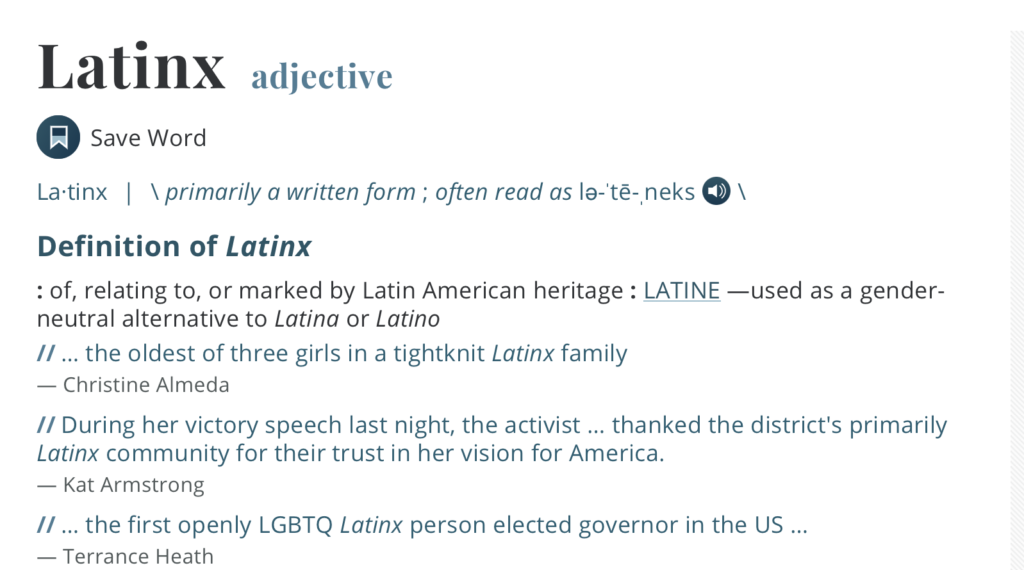Elle pronouns and “Latinx” might be the new words for Hispanic Heritage Month! We’ve been posting about él, ella, and elle pronouns all month on social media, and folks have been surprised and excited about the info.
So, we’d thought to post a roundup with the 411 on él, ella, and elle pronouns, along with expanded info and what you need to know about the term “Latinx.”
Get ready to learn a ton and celebrate Hispanic Heritage Month’s conclusion!
What Are Él and Ella Pronouns? And What about Ellx or Elle Pronouns?

You might also see folks listing their pronouns as:
- She/her/ella
- He/him/él
- They/them/elle or they/them/ellx
- Or even a combination of these, like she/elle, similar to she/they pronouns
For bilingual speakers of English and Spanish, including ella, él, elle, and sometimes ellx is a way to show their pronouns in both languages.
The Bilingual Pronouns Ella and Él

Ella is pronounced “eh-yah” and is the Spanish equivalent to “she” and “her.” Meanwhile, él is the equivalent of “he” or “him.”
“Informationally, bilingual pronoun sets can do double duty. Not only do they indicate a person’s pronouns, but they also indicate the two languages that a person speaks. Apart from its practical function, displaying a mixed-language pronoun set can also be a way for a person to express pride in their cultural identity.”
From Dictionary.com, Pronoun Explainer: What Do Ella, Él, And Elle Mean In Pronoun Sets?
Bilingual Neopronouns: Elle Pronouns and Ellx Pronouns

Some folks use they/them/elle to be inclusive of identities that fall outside the gender binary. Elle, pronounced “eh-yeh,” is a neopronoun that many use to work around Spanish’s gendered grammar. It is used similarly to the English singular “they.”
Some folks prefer the neopronoun ellx instead of elle, similar in construction to the inclusive term Latinx. (More on Latinx later in this blog!)
According to a great LinkedIn blog, she/her/ella, he/him/él, and they/them/elle pronouns can help folks better represent their identities:
“Elle is a push for progress in a language like Spanish where the nouns and adjectives you use to refer to yourself in everyday life are masculine or feminine.
“[Elle] provides an option for folks who identify outside the binary to represent themselves more authentically.”
From LinkedIn.com, ‘She/They’ and Other Pronouns You Might See on Candidate Profiles
The Evolution of Language: What Are Neopronouns? And How to Use Ellx or Elle Pronouns

Ellx or elle pronouns are “neopronouns,” or pronouns that are new constructions in Spanish.
Some argue that ellx or elle pronouns are “confusing” or “made up.” But this argument doesn’t consider the reality that communication is constantly changing. Language naturally evolves over time, reflecting the ever-changing realities of its speakers.
For example, Spanish speakers who live at the border use different variations than people in other regions. That doesn’t make their unique phrases and words any less valid.
Additionally, the pronoun “elle” is currently under consideration by the Royal Spanish Academy for inclusion in its dictionary. According to them, elle is a “non-generalized pronoun created to refer to those who may not feel identified with either of the two traditionally existing genders.”
Other neopronouns in English include xe/xem/xyrs, ze/hir/hirs, and ey/em/eir, which you can read more about in our blog, “Let’s Talk About They/Them Pronouns.”
Neopronouns are examples of “neologisms,” which are new, evolving words in common usage. According to Merriam-Webster, other neologisms include “webinar,” “malware,” and “blogosphere,” which demonstrate the evolution of language in our ever-evolving tech age.
Neopronouns Like Ellx and Elle Pronouns Are Actually Nothing New

In fact, as the Human Rights Campaign points out, creating neopronouns has a long history in language, including English:
“Although the term ‘neopronouns’ suggests pronouns that were recently developed, their use has been recorded for several centuries. During the 12th century, the Old English gender pronouns ‘he’ and ‘heo’ naturally evolved to a near indistinguishable pronunciation, which eventually led to the adoption of ‘she’ as a feminine pronoun.
“The English language has evolved over centuries and continues to evolve even in the present. Neopronouns are another example of this evolution and a step toward a society where people can more fully express all parts of themselves.”
From Understanding Neopronouns by the Human Rights Campaign
It just goes to show that it’s normal for languages to change over time, reflecting the real-world needs of the people who speak the language. As society opens to the idea that gender is a spectrum and not a binary, languages like English and Spanish will increasingly reflect those societal changes.
While Hispanic Heritage Month happens only once annually, being inclusive of folks who use elle pronouns can happen year-round!
Ellx or Elle Pronouns and “Latinx”
To really understand ellx and elle pronouns, it helps to understand the term “Latinx” as well. While many folks who use elle pronouns would identify as Latinx, not all people who use Latinx would necessarily use elle pronouns.
So What Does “Latinx” Really Mean?

“Latinx is essentially a non-binary form of Latino or Latina. The suffix ‘-x’ replaces the ‘-o’ or ‘-a’ corresponding to masculine or feminine, allowing the word to resist the gender binary. (In Spanish-speaking countries, the term Latine with the suffix ‘-e’ is circulating as an alternative to the -o/a binary.)”
Choosing the Right Word: Hispanic, Latino, and Latinx
Latinx is a term used by folks looking for a more inclusive, ungendered alternative. It is used by nonbinary folks, such as those who use elle pronouns, as well as those who wish to avoid gendered language. For example, in Spanish, if you have a group of 100 women and 10 men, one would still traditionally say “Latinos” and not “Latinas,” even though women greatly outnumber men.
As Katy Steinmetz writes in a Time article, “Feminists might balk at this the same way they’d balk at using he as a default pronoun or referring to mixed groups as ‘guys’ but never ‘gals.’ The subtext is the same: It’s a man’s world, you ladies are just in it.”
As an alternative to Latinx, some use the term Latine:
Latinx in the Dictionary
Just as elle pronouns are being included in more dictionaries, “Latinx” has been listed in Merriam-Webster since 2018 and the Oxford English Dictionary since 2019. Though Latinx has not yet been accepted by The Royal Academy of Spanish, the term has decidedly entered common usage, especially in the United States.

Most commonly, folks pronounce Latinx as “LAT-in-EX” or even “Laa-TEA-nex,” which rhymes with “Kleenex,” if that helps.
The word itself came into usage in the mid-2000s by activists who were unsatisfied by variations like Latino/a or even Latin@ in their search for a more gender-inclusive term.
It seems as though the word Latinx is here to stay:
“Academic centers are adding the word to their titles. The term is becoming de rigueur among artists and politically active youth. Media outlets like NPR are using it without remark or explanation. Another sign that this word has staying power: dictionaries have recently taken the time to define it.”
Time, Why ‘Latinx’ Is Succeeding While Other Gender-Neutral Terms Fail to Catch On
Like ellx or elle pronouns, Latinx is entering into more common usage, especially among younger folks. According to a recent Pew Report, those who are most likely to adopt the term “Latinx” are women between 18 and 29. (Note: Unfortunately, the study didn’t have categories for nonbinary-identified people.) So, including the term in your college messaging might be something to explore during Hispanic Heritage Month and beyond.
Key Takeaways for Él, Ella, Ellx, Elle Pronouns and Latinx for the 2022 Hispanic Heritage Month Roundup:

- Él, Ella, and Ellx or Elle Pronouns: For bilingual speakers of English and Spanish, including ella, él, or elle is a way to show their pronouns in both languages.
- Ellx and Elle Pronouns: These terms are new constructions that work around Spanish’s gendered grammar.
- Ellx or Elle Pronouns Are Bilingual Neopronouns: Neopronouns are examples of “neologisms,” which are new, evolving words in common usage. It’s normal for languages to change over time to meet the needs of speakers in the real world.
- Latinx: Another neologism is the term “Latinx,” which is a nonbinary form of Latino or Latina. Latinx is used by nonbinary folks and those who wish to be more inclusive and has been in the English dictionary since 2018.
We hope you enjoyed our latest blog and found a lot of useful info! If you’d like to keep reading, here are some other blogs you might find interesting:






